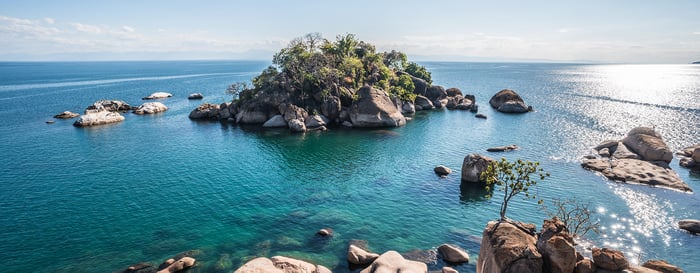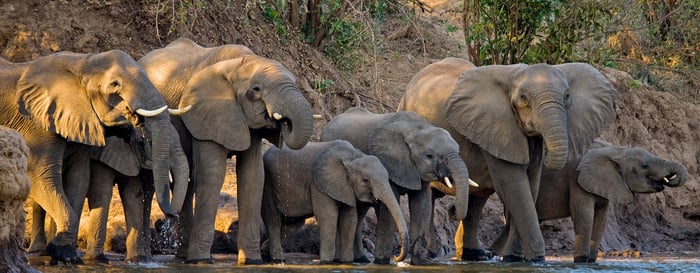Sri Lanka’s long running civil war was brutal and it looked as if our beaten up Land Rover had taken the brunt of it. Stalling and refusing to start was not the ideal introduction to a herd of elephants.
Udawalawe is one of Sri Lanka’s best and most popular national parks. Covering 30,821 hectares it is probably the premier place in the country to see wild elephants. Created in 1972 it offer sanctuary to animals displaced by the damming of the Walawe River.
We had been greeted at the gate by our hawkeyed ranger. While he didn’t speak much English, he proved to be a dab hand at knowing the best spots for wildlife.

Spluttering our way into a thicket we came to a halt behind a red Tata. As the driver cut the engine a small herd of elephants slowly made their way across the road. Around 500 pachyderms call the park home. In this largely arid area they are attracted by the abundant water provided by the reservoir. Chena cultivation (shifting slash and burn) was used in the area before the establishment of the park and so the vegetation is not as thick as in some other parks making it ideal for elephant spotting.

When the elephants walked past our Land Rover refused to start. A helping push start from the rangers coaxed the beast back into life and for the rest of the safari we were accompanied by the coughing of the Defender’s diesel engine as the driver was too afraid to cut it.
Once more on the move we didn’t need to wait long for our next elephant. Standing no more than ten metres from the track a young male was busy chewing on a branch. Better than any reality television show we watched him eat while he watched us take pictures.
A muddy approach brought us alongside a pool of wallowing water buffalo offering up a breakfast buffet for a flock of cattle egrets. Water buffalo numbers are boosted by encroaching domesticated specimens.

Animals in the park remain largely unfazed by the jeeps and you can usually get up very close to them. Although there are leopards they are rarely seen and you are much better off going to Yala for cats. Sambar deer can also be found roaming the park, although we didn’t see any. Uda Walawe is great for bird watchers and there also plenty of lizards to see plus the odd crocodile.

A little further along the track our truck shuddered to a halt once more as our guide excitedly pointed to a tree. For a moment all we could see were the spindly branches, but high near the crest was a lizard surveying the land. However, we didn’t have to look as hard when we had our next lizard encounter, as a craggy monitor lizard brazenly hissed its way beside us on the muddy track.
Like the initial lizard, Sri Lanka’s birds can also be tricky to spot so you need someone with an eagle-eye and a pair of binoculars with you at all times. For instance, a peafowl’s camouflage will keep them perfectly hidden until they make their haunting cries. It’s a similar story with the parakeets who tend to favour the branches around hollows in trees to perch.
Sri Lankan birds tend to be quite colourful. Perched on a bare branch a blue-tailed bee-eater is eye-catching but is still actually quite well camouflaged against the surrounding vegetation. At a pool waders are busy at work and do not appreciate our disturbance when they have a job at hand.
There are plenty of birds of prey. Early in the morning they tend to sit it out in the trees waiting for thermals to send them soaring. As the day starts to heat up they glide effortlessly on patrol looking for prey.
The nearby Elephant Transit Home, set up in 1995 by the Department of Wildlife Conservation, aims to rehabilitate orphaned baby elephants for release into the wild. For this reason human contact is kept to a minimum, unlike at the better known Pinnewala Elephant Orphanage.
Sri Lankan elephants are the largest of the three recognised subspecies that make up Asian elephants. Females generally do not have tusks and these days only around seven percent of the male population has them and so they have not been subject to the level of poaching suffered by other elephant populations. The island is thought to have the highest population density of pachyderms in Asia.

A growing human population has caused increased conflict between farmers and elephants. Landmines left from the war have also led to many fatalities amongst pachyderms often resulting in motherless baby elephants. Feeding times (9am, noon, 3pm and 6pm) allow visitors to see the residents come rushing from their day enclosures to the feeding area. Visitors watch from a distance separated by a fence and ditch. The youngsters eagerly gulp their milk formula ration, distributed with a funnel and tube, before the younger more boisterous ones go on to harass the ever present cattle egrets. When they reach a suitable age they are rehabilitated into national parks including Udawalawe.
Much of the area surrounding the park is also good for wildlife spotting. I saw a troupe of tufted grey langurs, peafowl and monitor lizards all at close quarters where I was staying.
The park experience is ultimately dependent on how well the driver and ranger work together. Some operators tend to stick to the same paths, you want one not afraid to dive off on some bumpy track. We didn’t see any mammals apart from elephants and water buffalo, to do so is partly a matter of luck but also requires going to different habitats in the park. There are more forested places particularly at the edge of the mountains rather than the more open plains but we didn’t go there. Our guide managed to spot a mugger crocodile at the side of a pool but it was largely obscured by vegetation. And it is reptiles along with birds that appear to be the easiest things to see other than the very large animals. There is not the variety of creatures that you would see in Africa but nonetheless it is exciting and worthwhile.
Classic Uganda
-
Observe the antics of wild chimpanzees in Kibale National Park, Uganda
-
Take a boat cruise down the Kazinga Channel in search of hippos
-
Spot rare black-maned, tree-climbing lions in Ishasha
-
Be humbled by a gorilla encounter in Bwindi Impenetrable NP
-
Enjoy unbelievable birdwatching opportunities in Africa
Southern Malawi Adventure
-
Snorkel amongst vibrant cichlid fish in Lake Malawi
-
Experience life on a tea and coffee estate in Thyolo
-
Witness rare wildlife in their natural habitat at Liwonde
-
Engage with local Malawian communities
-
Relax on the tropical island paradise of Mumbo Island
Two River Safaris
Luangwa Valley Lower Zambezi Zambia Africa
- Combine two of Zambia’s best National Parks
- Walk between the camps in South Luangwa following the Luwi River
- Experience a “Return to the Wild” sleep out night in Kakuli
- Paddle in canoes and fly fish in the Lower Zambezi
- Enjoy a sunset boat trip, drifting downstream while watching buffalo and elephant
.jpg)







